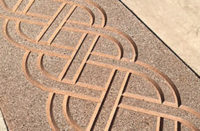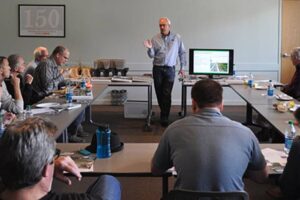In winter and during the holidays, concrete construction slows dramatically. We have more time to think about next season. Finding jobs is foremost on our minds as we contemplate strategies for getting more work. How can I give myself an edge over my competitor? How can I differentiate myself from every other concrete contractor? The answer – architects.
An underutilized opportunity for potentially creating more jobs and visibility for your company exists within the design community. Architects and landscape architects are key members of the project team for commercial and high-end residential installations. They design the project and are involved with product research and selection.
Most contractors are only involved with the designer when a project commences if at all, often with little initial input regarding the methods and means of achieving the owner’s vision for the decorative concrete. Understanding the design team’s needs during every stage of a project and developing the tools or skills to satisfy those needs can greatly improve your chances of influencing and securing more work.
The initial step is simply getting in front of an architect, long before the first shovels of dirt are turned on a project, and positioning oneself as a reliable resource for decorative concrete information. Many contractors seem intimidated by architects, since the contractor may assume an architect is already quite knowledgeable about decorative concrete. From my experience, just the opposite is often true. Considering the incredible number of products and processes involved with a building’s construction, an architect does not have the time or inclination to be an expert on each element of construction. Your many years of hands-on field experience will be welcome and respected if you interact with an architect proactively as a consultant, not just as an installer after the job starts.
Doing a little homework before you contact a design firm is important. All design firms maintain a Web site that contains information about the firm: areas of expertise or types of projects they typically design, professionals on staff – architects, landscape architects, interior designers or engineers – and a portfolio of completed projects. It might be best to meet with a firm that is staffed predominantly by landscape architects rather than interior designers. A firm that is focused on streetscape projects or educational facilities is a priority over a residential firm. An office staffed with two architects should be visited after meeting with the firm staffed by a dozen architects. Don’t inadvertently spend an hour talking about polished and stained concrete floors only to discover you are talking to a landscape architect who is only interested in exterior paving. Armed with good information, you can decide where to spend your time.
If you find speaking with architects to be nerve-racking, minimize the stress by letting your past work – that is, your photo album or online photo gallery – speak for you. Architects and landscape architects relate or respond well to visual representations. A project picture (remember, a picture is worth a thousand words) may more thoroughly convey your thoughts than anything you might say. Once you have directed the conversation towards a specific job, speaking with an architect is much easier, since you are talking about a job with which you have direct experience as opposed to worrying about saying the right thing.
As you look for opportunities to strengthen or broaden your reputation as a reliable and knowledgeable decorative concrete consultant, move beyond the office and job-site trailer visit. The American Institute of Architects (AIA), American Society of Landscape Architects (ASLA) and Construction Specifications Institute (CSI) often have state chapters that, through local product shows, chapter meetings and social events, and chapter publications, allow you to further expand your visibility among their members.
Additionally, architects and landscape architects need continuing education to maintain their state license or their professional credentials for their organization. By becoming a continuing education provider, or by partnering with a supplier or manufacturer that has developed a continuing education program, you greatly enhance your credibility within the design community. The time spent in an architect’s office during a lunch and learn is invaluable. You have the opportunity to meet key personnel: specification writers, project architects, principals, and even the receptionist or gatekeeper, which can be helpful on future calls.
Previously I commented on the importance of a photo album or online photo gallery as an effective means of creating awareness about your products and services. Expanding on the photo concept, finished samples provide an even better visual representation of the prospective decorative concrete installation. Cast samples combine the selected elements of color, pattern and texture into a more understandable whole, which is often difficult to evaluate just by viewing color charts and pattern selection guides. The cast samples also help the architect convey his vision to the client. Even more importantly, finished samples help you create realistic expectations for the installation. You may even find that your finished samples become the reference standard for a project.
As you evolve into a consultant’s role, knowing your product, as well as your competitors, is important. Your ability and willingness to discuss the qualities of your product compared to alternative or even competitive systems will be appreciated by the architect.
Most project specifications contain language that addresses product choices. Consequently, the more informed an architect is about product options, the more likely he will write a specification that is clear, correct and complete. It creates a construction document without ambiguity, which improves the bidding and installation process. It makes the architect look good. It elevates your stature in the eyes of the architect. It is important to note that when discussing your product versus competitive materials, you should do so within the context of features and benefits, not by bad-mouthing the competition. Negative selling should never be used to promote your talents or products. Also, ask lots of questions and listen, pay attention and take notes. Remember, the meeting is not just about your concerns. Probe by asking questions so you understand the challenges the architect is facing on the job and provide relevant solutions.
The more successful contractors have established their credentials with designers by developing the skills I have briefly outlined. They have become an integral part of the design process, and for those efforts, are able to secure more profitable work. When work is slow, it is the ideal time to meet with architects and plant the seed for future jobs.
















